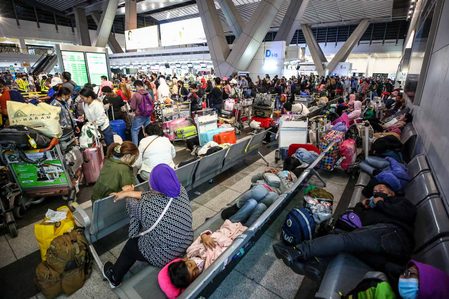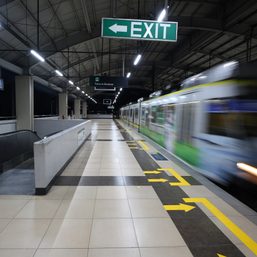SUMMARY
This is AI generated summarization, which may have errors. For context, always refer to the full article.

MANILA, Philippines – In a span of just seven weeks, the proposals to rehabilitate the Philippines’ troubled main airport were evaluated and decided on by the powerful board that approves high-impact and capital intensive infrastructure projects.
The National Economic and Development Authority (NEDA) Board, chaired by President Ferdinand Marcos Jr., decided to go with the solicited proposal of the Department of Transportation (DOTr) and Manila International Airport Authority on how the private sector should go about the rehabilitation of the Ninoy Aquino International Airport (NAIA).
This effectively junked the unsolicited proposal of the super consortium of the Philippines’ richest tycoons, collectively called the Manila International Airport Consortium (MIAC).
The swift decision of the NEDA Board, made just a week before Marcos’ second State of the Nation Address, triggers the tedious competitive bidding process. It will take some time before the actual rehabilitation effort to overhaul the airport, once dubbed the world’s worst, begins.
But for perspective, NEDA Secretary Arsenio Balisacan said that the government’s scrapping of MIAC’s P267-billion proposal in favor of DOTr’s P170-billion plan significantly cuts down the number of months that could have been spent on negotiations – besides more paperwork and calculations.
“Kung unsolicited kasi, marami kayong pag-uusapan, ‘yung solicited nilabas mo na lahat. Ito ang ime-meet, ito ang criteria. If you’re not willing to, ‘wag ka magbi-bid, so in that sense, mas mabilis,” Balisacan said in an ambush interview on Wednesday, July 19.
(If it’s an unsolicited proposal, it would entail discussion of a lot of matters, unlike a solicited proposal, where all criteria are spelled out. These are what you have to meet. If you’re not willing, don’t bid. So in that sense, it’s faster.)
Recall that the Duterte administration went through several rounds of discussions under the unsolicited proposal, only for the consortium to walk away.
What can be achieved this year?
Transportation Secretary Jaime Bautista told Rappler it’s unlikely that by year-end the private concessionaire will be named and the actual rehabilitation of NAIA will begin.
The publication of the terms of reference is the first step and may happen within the next two weeks, according to Bautista.
“We’ll have to meet with [interested parties first]. There will be some clarification. It will take us some time,” Bautista told Rappler in an interview on Wednesday, July 18.
“After the publication of the terms of reference, we will encourage them to submit within 60 days. They might ask for an extension. Puwede naman siguro (We can probably do that) for another month.”
Initial talks may be completed within the year, but the process of financial closing could take up to six months to finish, according to Bautista. A financial close refers to a stage in the public-private partnership (PPP) agreement wherein all financing documents have been signed and all conditions related to financing have been met, allowing the private party to start accessing funds for the project.
“Normally, it takes them around six months to do the financial closing. But if you can do that earlier, the better. We can start the rehabilitation as soon as possible, right after the financial closing,” Bautista said.
Interestingly, MIAC was confident that it had an edge over a solicited proposal in terms of speed, claiming that its technical studies and financial closing were all “ready to go.” Filinvest Development Corporation president and chief executive officer Josephine Gotianun-Yap estimated that if the DOTr settled on a decision by the end of 2023, MIAC could immediately work on implementing the rehabilitation by early next year.
“It will be very fast for us to get this project done. Unlike in the solicited proposal, when the party is announced, they will still do their financial closing, which will sometimes take as much as a year. So we believe that this is the fastest way for the government to get this project done,” Gotianun-Yap said in an interview on ANC’s Headstart on June 20.
What does the solicited proposal look like?
The P170.6-billion solicited proposal’s main goal of rehabilitation remains the same, where it seeks to rehabilitate, operate, expand, and transfer NAIA. Specifically, the proposal aims to:
- Increase airport capacity from 35 million passengers per annum to 62 million
- Increase air traffic movements per hour from 40 to 48
- Improve service by applying internationally-benchmarked Minimum Performance Standards and Specifications
- Utilize private sector expertise for modernization and capacity expansion
Apart from these, Bautista said that the private entity that is willing to do and finance all these will have to set their bids.
“It’s a solicited one which will require the proponent to offer the proposal to improve the operations of Manila International Airport, which will involve investment in infrastructure. They will have to give us an offer on how much revenue can be shared to the government,” the transport secretary said.
Bautista also confirmed that the concession period – the length of time in which the private sector will operate the airport – will be 15 years, with a possible 10-year extension based on their performance.
“We will require them to follow minimum performance service standards. The term of the concession is 15 years, extendable by 10 years, subject to their performance. If they will perform better or if they will be able to meet the expectations of government, that can be extended,” he said.
The private concessionaire will be required to give an upfront payment to the government, the amount of which Bautista declined to disclose. The revenue-sharing scheme between the private concessionaire and the government is also still up for negotiation.
Financing
Meanwhile, Balisacan underscored the need to ensure the private sector’s financial capabilities. More importantly, when it intends to spend the bulk of the funds.
Balisacan and Bautista were asked, “When do you expect the expenditures of the capital to come in? Toward the front or toward the end?”
Both said that government would like to see the bulk of the spending right at the first few years of rehabilitation, given NAIA’s structural needs.
When the capital will be spent will also have implications on the terminal fee structures, as well as revenue sharing, according to Balisacan.
“There will be an upfront payment to government, plus revenue-sharing. That’s what they will propose to us,” Bautista said.
MIAC still welcome
MIAC may still join in the bidding process, but they would need to follow the parameters of the solicited proposal.
In a vaguely worded statement, MIAC said it “understands” the government’s decision to go with DOTr’s solicited proposal.
MIAC comprises the same companies that attempted to rehabilitate NAIA during the Duterte administration, namely Aboitiz InfraCapital, AC Infrastructure, Asia’s Emerging Dragon Corporation, Alliance Global-Infracorp Development, Filinvest Development Corporation, and JG Summit Infrastructure Holdings Corporation. They have a new foreign partner, Global Infrastructure Partners, which operates several airports overseas, including the Gatwick Airport in the United Kingdom.
“Regardless of the route, we firmly believe that NAIA’s modernization requires a long-term and comprehensive solution delivered by a credible and capable party at the quickest possible time. These criteria – regardless of the approach – would best benefit NAIA and the Filipino people,” the statement read.
Will MIAC push through with their intention to rehabilitate NAIA or are there other companies that will place their bids? – Rappler.com
Add a comment
How does this make you feel?




![[OPINION] Clark International Airport, one of world’s most beautiful airports, is badly underutilized](https://www.rappler.com/tachyon/2024/05/clark-airport-underutilized-may-28-2024.jpg?resize=257%2C257&crop=560px%2C0px%2C720px%2C720px)






There are no comments yet. Add your comment to start the conversation.